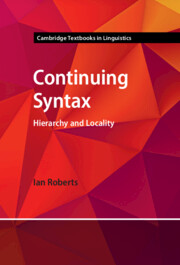Book contents
- Continuing Syntax
- Cambridge Textbooks in Linguistics
- Continuing Syntax
- Copyright page
- Contents
- Preface
- Abbreviations
- Part I Configuration and Hierarchy
- Part II Locality
- 10 Wh-Movement: Unbounded Dependencies, Islands, Subjacency and Barriers
- 11 Covert Movement, Copy Theory and Reconstruction
- 12 Phases and Phase Impenetrability
- 13 Types of Locality: Phases and Relativised Minimality
- 14 The Syntax of Silence I: Ellipsis
- 15 The Syntax of Silence II: Empty Pronouns
- 16 Wrapping up: Parameters, Features and Futures
- Glossary
- Book part
- Index
- References
14 - The Syntax of Silence I: Ellipsis
from Part II - Locality
Published online by Cambridge University Press: 03 October 2025
- Continuing Syntax
- Cambridge Textbooks in Linguistics
- Continuing Syntax
- Copyright page
- Contents
- Preface
- Abbreviations
- Part I Configuration and Hierarchy
- Part II Locality
- 10 Wh-Movement: Unbounded Dependencies, Islands, Subjacency and Barriers
- 11 Covert Movement, Copy Theory and Reconstruction
- 12 Phases and Phase Impenetrability
- 13 Types of Locality: Phases and Relativised Minimality
- 14 The Syntax of Silence I: Ellipsis
- 15 The Syntax of Silence II: Empty Pronouns
- 16 Wrapping up: Parameters, Features and Futures
- Glossary
- Book part
- Index
- References
Summary
In this chapter we observe that syntax is mostly silent; given the overall organisation of the grammar, there are good reasons to expect this to be the case. Furthermore, among the silent elements there are, in addition to copies, empty pronouns and covert movement, various kinds of ellipsis. VP or predicate-ellipsis is quite rich in English, while NP-ellipsis is meagre. Ellipsis displays a number of departures from absolute identity of the antecedent and elided constituent, notably but not only sloppy readings and voice mismatches. We also look at the distinction between deep and surface anaphora and, following on from this, evidence that radical prodrop in East Asian languages appears to involve NP- or argument-ellipsis.
Keywords
Information
- Type
- Chapter
- Information
- Continuing SyntaxHierarchy and Locality, pp. 272 - 289Publisher: Cambridge University PressPrint publication year: 2025
References
Primary Sources
Secondary Sources
Accessibility standard: WCAG 2.2 AAA
Content Navigation
Allows you to navigate directly to chapters, sections, or non‐text items through a linked table of contents, reducing the need for extensive scrolling.
Provides an interactive index, letting you go straight to where a term or subject appears in the text without manual searching.
Reading Order & Textual Equivalents
You will encounter all content (including footnotes, captions, etc.) in a clear, sequential flow, making it easier to follow with assistive tools like screen readers.
You get concise descriptions (for images, charts, or media clips), ensuring you do not miss crucial information when visual or audio elements are not accessible.
You get more than just short alt text: you have comprehensive text equivalents, transcripts, captions, or audio descriptions for substantial non‐text content, which is especially helpful for complex visuals or multimedia.
Visual Accessibility
You will still understand key ideas or prompts without relying solely on colour, which is especially helpful if you have colour vision deficiencies.
You benefit from high‐contrast text, which improves legibility if you have low vision or if you are reading in less‐than‐ideal lighting conditions.
